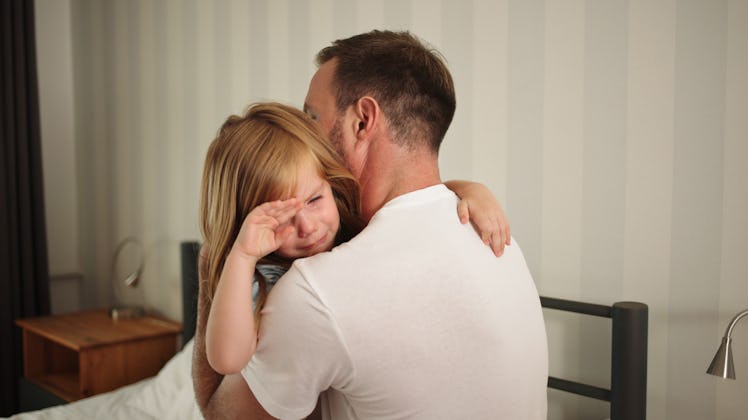How To Comfort A Child After Mom Or Dad Gets Angry
Parents aren’t supposed to lose their temper, but everyone does. It’s still possible to be a good parent afterward.

It’s hard being a calm parent. The lack of sleep, the uncertainty of inexperience, the social pressures from other people — all of it undermines the effort to stay chill. Parents aren’t supposed to lose their temper, but they inevitably do. And that’s upsetting to children. If it happens a lot early in life, research indicates that the stress of exposure to anger can create behavior patterns that affect future socialization, emotional management, and self-esteem. Exposure to volatility can even lead to anxiety issues and OCD. Although the ideal solution may be to remain calm, the more workable solution is to know how to calm a kid down.
“Children constantly learn from their environments, especially their primary relationships,” explains Shanna Donhauser, a family therapist and childhood mental health specialist in Seattle. “Rupture and conflict are inevitable. But repairing those ruptures strengthens relationships and builds the foundation of trust, comfort, and safety.”
Donhauser has identified four steps to help parents help their children work through the frightening experience of witnessing a parent’s anger. And it is work — acting like it didn’t happen isn’t a solution. Left to process those emotions and experiences on their own, kids may draw some very unhealthy conclusions. Here are those four steps.
Calm Down
Before attempting to console a frightened child, parents need to get a firm grip on their own emotions.
“It’s like the airline safety rule: Secure your own oxygen mask before attempting to help others,” Donhauser says. “You cannot support your child when you are still angry or in the process of calming down.”
If it takes time to calm down — if a long walk or trip to the gym is in order, or at least a prolonged cool-down period — it’s okay for parents to explain to the child what is happening, where they’ll be, and to reassure them that they’ll return to talk about what happened.
Reflect on What the Kid Has Experienced
Parents should see the situation from the child’s perspective — a parent is bigger, stronger, and louder. Were there aggressive gestures or posturing? Was something thrown or broken?
“Don’t do this until you are calm,” warns Donhauser. “It will likely reactivate your emotions a little.”
Repair the Damage
Once calm and having reflected on their child’s experience, parents need to make a sincere effort to reconnect. Inviting the child to sit in a safe and comfortable space is a good start. Some kids won’t want to talk directly about what happened and will want to play as they work through their emotions. That’s okay.
“Share your intentions and emotions,” advises Donhauser. “Then bring your child into the repair process so that they can co-create solutions to this problem. Children are creative and often come up with great solutions when given the opportunity. When invited to create solutions, they are also more likely to remain cooperative and follow through.”
Connect With the Kid
After the repair, parents should find opportunities to connect with their child — through a trip to the park, a bike ride, or just playing together. This isn’t “making up” for anything; instead, it’s to show how the relationship is still strong.
Parents need to realize that children don’t merely feel physically threatened by a display of anger. They’re also worried that the relationship itself is in danger. That’s why it’s so important for parents to maintain control. If they can’t, they should consider seeing a professional. It can feel embarrassing or shameful to address a loss of control in blunt terms; it can feel even worse seeking professional help for unhealthy behavior patterns. But it’s a parent’s duty to make the hard decisions.
This article was originally published on